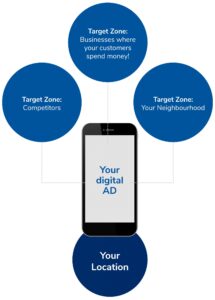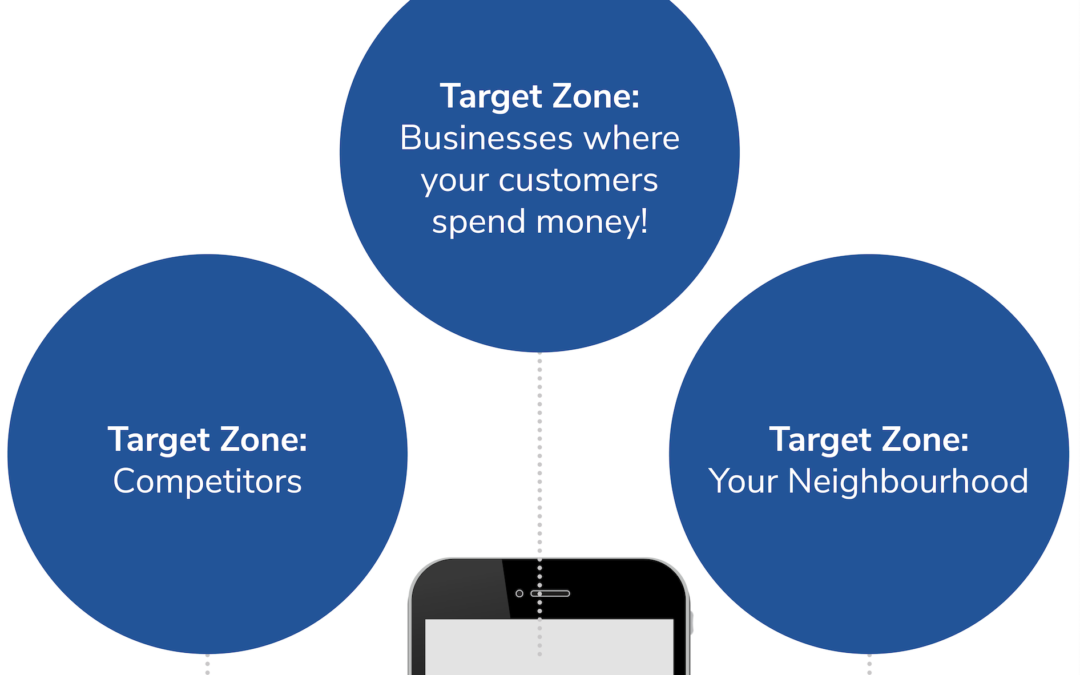It seems a little bit wrong to be writing about geofencing when nobody is supposed to be running around or going out. This being said, when we think about a post-coronavirus world, business owners are going to want to have every advantage working for them. And one of them can be having the ability to reach desired audiences easily, effectively and with measurable results.
What exactly is geofencing and what it can do for local businesses
Geofencing technology uses GPS or RFID technology to create a virtual geographic boundary, enabling software to trigger a display ad when a mobile device enters or leaves a particular area. By setting up precise virtual fences around strategic locations (like your competitors or other locations where your ideal clients frequent) , business owners can benefit from building a custom audience and advertise their positioning, an offer or products directly to this audience. This allows for the elimination of many wasted impressions and dollars spent advertising to people that will never shop at their location.
How geofencing works
 It’s actually quite cool. Refer to the infographic to get your bearings.
It’s actually quite cool. Refer to the infographic to get your bearings.
- Someone enters a targeted geofenced zone. (Competitors, a specific neighbourhood, etc..)
- Our technology identifies them as a potential prospect
- An algorithm targets the best profile people with your ads
- Technology tracks if they walk into your store within 30 days
So what is a “targeted geofenced zone”?
This could be many things depending on what your business is, who you cater to, your price point, where you’re located and other factors. Imagine you run a high-end restaurant, your targeted geofenced zones could include:
- Other restaurants in the same category as yours
- Restaurants that match your price point but don’t specialize in the same menu as you
- Stores and retailers that cater to the same clientele that match your ideal clientele
- Office buildings in your neighbourhood
What if you run a neighbourhood store? Well, your targeted geofenced zones may include:
- Other stores in your neighbourhood
- Office buildings in your neighbourhood
- Competitors near you
- Competitors outside of your neighbourhood
When you decide to move forward with a geofencing campaign, it’s important to map out your strategy beforehand so you can identify these zones in advance and develop ads that speak to the people you’re trying to reach.
Why is geofencing an excellent form of advertising to consider?
Geofencing campaigns are an excellent way to reach people and provide advertisers with concrete metrics they can’t get with other forms of advertising.
Print ads? Print is in decline and the metrics are imprecise. Billboards? How do you know for sure a precise number of people that are driving by and absorbing the ad on the board? Radio advertising? There is no precise way of knowing who is focussed on the ads or if the listener changes the station. TV spots? Again, channel surfing, DVR technology and on-demand content make it impossible to know exactly how big an audience you’re reaching.
With geofencing, you get the benefit of real metrics that prove a real return on investment. How so? When someone enters a target zone, they become tagged. This automatically creates a test group and a control group to be compared. One group will see the ad, while the other does not. But because both groups are tagged, it is known when an individual walks into your location whether they’ve seen the ad or not.
This gives you two conversion rates (with your location being the “conversion zone”). The first is the natural conversion rate, which is the percentage of the people who enter your location without seeing an ad. The second is the campaign conversion rate, which is the percentage of people who enter your location after being exposed to your ad. We can then compare the two rates and understand how the ads have impacted conversion. All these metrics are available to advertisers and they’re much more precise than the numbers you would get from the other forms of advertising mentioned earlier.
Calculating ROI
Building on this, the business owner can then work out exactly what the camping return on investment is. All they would need to know is the following:
- The number of people who enter their location because of the ad, which would be provided on a regular basis by the provider
- The percentage of people they’re able to convert to sale once they’re at the location
- The average sale in dollars
So your formula will look like this:
(Number of walk-ins * conversion rate) * average sale = ROI
Using an actual example, let say a very good restaurant converts 90% of everyone who enters the shop to a sale and the average sale is $130. That formula would be:
(50 * 90%)* $130 = $5,850
In a typical campaign, the business owner would pay about $100 for about 10,000 impressions. In the example above with real numbers, that business owner is paying for 50K impressions, so his real return is $5,850 – $500 = $5,350. Not bad for a monthly campaign.
Where to go from here
10|20 Marketing is now running geofencing campaigns. This kind of advertising is an excellent companion to our Local Listings Management package as they are both measurable from a foot traffic generation perspective. When the time is right, if you would like more information about our process, successes and other opportunities, just reach out for a free small business marketing consultation.
In the meanwhile, you may be interested in two posts we’ve written about getting through this health crisis:
- BEST PRACTICES FOR GOOGLE MY BUSINESS TO LESSEN THE IMPACT OF COVID-19 SECURITY MEASURES
- 10 WAYS TO CONTINUE SUPPORTING LOCAL BUSINESSES IN CHALLENGING TIMES
In addition, we’ve recently launched a series to spotlight hard-working business owners we know. If you’d like to be featured, please email mark@10-twenty.com with the subject line: “Spotlight Series Request” and we’ll be happy to accommodate you.

